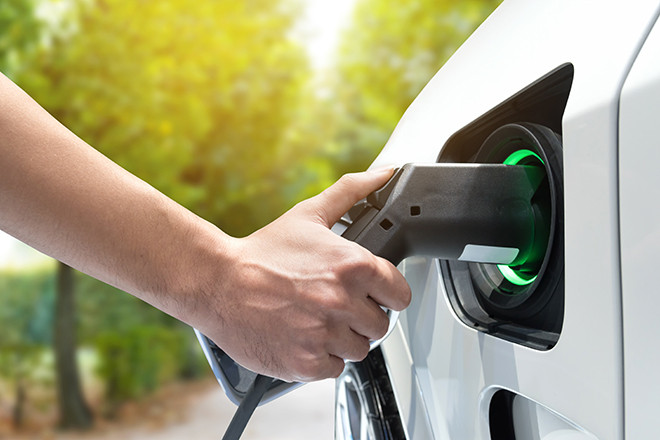Future transportation: going the EV way
The transition of automobiles towards electric mobility is inevitable and it is for the auto industry to make the change and drive it.
Electric vehicles (EVs) are becoming the next automotive technology to be extensively diffused in society. EVs have witnessed an unprecedented global interest in recent times, emerging as one of the most promising alternative power train technologies with zero tailpipe emissions and long-term economic viability. The global automotive industry is at the cusp of a paradigm shift from internal combustion engine vehicles to zero-emission vehicles.
According to International Energy Agency (IEA) Global EV Outlook 2021 report, there were 10 million electric cars on the world's roads at the end of 2020, following a decade of rapid growth. Electric car registrations increased by 41 percent in 2020, despite the pandemic-related global downturn in car sales in which global car sales dropped 16 percent.
Around 3 million electric cars were sold globally (a 4.6 percent sales share), and Europe surpassed the People's Republic of China (China) as the world's largest EV market for the first time. Electric bus and truck registrations also expanded in major markets, reaching global stocks of 600 000 and 31 000 respectively.
Despite a turbulent year, major companies globally are accelerating the transition to e-mobility by shifting fleets to EVs and installing charging stations.
ASIA PACIFIC
Globally, countries are making advances in EV adoption as emission-free vehicles continue to be recognized as a crucial pillar to sustainability progress.
In the Asia Pacific region, various countries are already experiencing, or are poised for, excellent growth – and the key every time, is the customized approach they take to their EV priorities.
The World Energy Storage Day 2021 Global Conference & Expo, brought together industry veterans, policymakers, academia, innovators, and professionals from around the world on a single platform to deliberate on the role of e-mobility for transitioning to low-carbon, green transportation discussed the emerging trends and development of EVs in the Asia-Pacific region.
Balancing EV pricing & customer satisfaction
EVs are in their growth phase, as the adoption is kicking in at a steady pace. With the government placing impetus on accelerating green means of transport that are affordable yet sustainable to customers through policy interventions and purchase subsidies.
Dr. Gustav H. Beerel, Country Head-Japan - Customized Energy Solutions, said: "At present, EVs are in the 'introduction' and 'growth' phase. Pricing and customer satisfaction are critical in sustaining this phase, as innovators and early adopters are the key stakeholders in this development."
Advancing power systems for accelerating e-mobility
Speaking about e-mobility being a power problem and not an energy problem, Pete Tickler, Co-Founder and Head of Product – Gridcognition, said: "E-mobility is a 'power problem', not an 'energy problem', as energy systems are increasingly becoming power system with decarbonization efforts in all sectors."
Cell-level control for longer battery life
A cell-level control approach for EV battery packs enhances traditional battery balancing goals to not only provide cell balancing but also achieve significant pack lifetime extension. These goals are achieved by applying a new life-prognostic-based control algorithm that biases individual cells differently based on their state of charge, capacity, and internal resistance. Zezan Tam, Vice President - Strategy and Business Development, Relectrify, said: "Relectrify's cell-level control electronics help improve battery life, reduce costs, and improve safety and resilience to individual cell failures."
Adopting V2G technology for low volatility
The growth of EVs and the smart grid has led to the creation of vehicle-to-grid (V2G) technology.
V2G technology involves drawing unused power from the car into the smart grid. V2G, which is also known as vehicle-grid integration (VGI), can help the energy grid supply electricity during peak hours.
It can also provide an added benefit to consumers by potentially lowering the cost of EV ownership. An owner can sell back surplus power from their vehicle to offset other costs.
Gregory Poilasne, Co-Founder, Chairman & CEO – Nuvve, said: "Electric grid is not ready and smart charging will not be enough to address the needs of the EV industry. An ideal solution is to develop vehicle-grid integration to achieve low volatility."
Expounding on the importance of adopting V2G technology for EVs, Kenji Yodese, Manager, Toyota Tusho Co. said: "Balanced power with V2G technology is essential to expand the reach of renewable energy in the emerging market."
INDIA, SAARC & RUSSIA
India is on the tipping point of revolutionizing its mobility system. E-mobility has established itself as a feasible successor to the internal combustion engine (ICE) vehicles of today and the future of India's mobility landscape has begun to look progressively electric. India's efforts in implementing several policies, involving FAME II, indicate the country's vision for a shared, clean, and connected mobility system.
Creating ideal infrastructure for EV adoption
The National Electric Mobility Mission Plan (NEMMP) and Faster Adoption and Manufacturing of (Hybrid &) Electric Vehicles in India (FAME I and II) have helped in creating initial interest and exposure for electric mobility. After that, schemes and interventions have driven electric mobility at the central and state levels. Vikram Gulati, Country Head & Sr. VP – Toyota Kirloskar Motors, said: "Despite huge efforts to spur e-4W adoption, projections by BNEF for India by 2025 are 1.8 to 2 percent penetration of new vehicles sales. By 2030, it will be 8 percent. Going forward the government can have a huge impact on off-take for BEVs as well as the creation of infrastructure for the adoption of EVs."
The key here is to bring down the price of EVs, for which we need to see how rapidly we can scale up manufacturing of EV parts in India at a global scale and global quality. PLI will play a part, but the government needs to connect taxation structure to vehicles based on carbon emissions, Mr. Gulati added.
Testing critical to ensuring battery safety
Since EVs are at risk of damage from collisions, batteries must contain various safety mechanisms to guarantee that under no situation can the battery ignite.
While there are many standards and regulators, the tests designed for battery safety are all concentrated on safeguarding that EV batteries can withstand various environments and conditions that could cause safety issues. Sadaf Siddiqui, Marketing Manager (IoT, Automotive) - Keysight Technologies, said: "Testing is critical because we are talking batteries which will be the heart of the systems. We have instances of batteries in smartphones exploding, so we must be very sure that we have done enough testing with the right tools and deployed sufficient resources. Undoubtedly, test and measurement play a vital role for products using batteries."
EV cost parity through subsidies
The high preliminary cost of electric cars is often cited as one of the key barriers to driving EV adoption. Incentives play an important role in helping to achieve cost parity between EVs and ICE vehicles. The incentives will need to be sustained soon to address the upfront cost barriers and make electric cars attractive to consumers.
Martin Zierer, Application Manager - Schaltbau GmbH, said: "The total cost of ownership of the EV is better than the combustion engines. We just have a high investment that needs to be overcome. Until that price parity is achieved, there needs to be some governmental tax relief or concessions. In Germany, the taxation on a car is strongly linked to the carbon output. So, an EV is given taxation benefits. This is an excellent tool to incentivise the purchase of EVs."
Enabling efficient EV charging ecosystem
As the EV industry grows, more and more charging stations are being constructed in key locations. Some of the benefits of having an EV charger at home.
- Cheaper - After covering the cost of installation, electric bill charging costs will be cheaper compared to payments in public charging stations. It also provides real-time data of used energy for tax benefits claims. There are also smart solar charging stations that utilize excess solar power when scheduled.
- Faster - An effectively installed home car charger can charge the battery in full anywhere between 45 minutes to 7 hours. Much quicker than charging in public stations. Yes, there are rapid charging points, but those aren't cheap.
- Convenience - Having an electric car charger gives control of when to charge. There is no need to rely on public charging stations. This ends the countless days and wastes hours in lining up and waiting for the EV to be charged. Just plug in the EV to the charger and focus on the things to be done. With enough charge for daily consumption, long voyages are the only time that an EV needs to visit a public charging station.
- Battery Life - The battery of an EV is like a smartphone's battery. It becomes less effective over time. Constant use and charging also reduce its capacity to hold power. To slow down the degradation of the battery it is recommended to have an almost full battery, rather than a few hours taps on a public charging station. Having a home EV charger is ideal for this type of charging situation.
Anant Nahata, Managing Director - Exicom, said: "Charging is a critical element of the ecosystem especially when we are talking about EV adoption. In India, currently, 99.5 percent is home charging, and it will remain the dominant mode. It is critically important therefore that home charging should be made smooth."
Accelerating EV demand
Battery production capacity will probably need to outpace EV demand to meet the rising need for lithium-ion power in other sectors, along with alleviating supply and production constraints. Dr. Ashok Saraswat, Head of Advance Battery Engineering & Chief of Center for Cell and Battery Research - Ola Electric Mobility Pvt Ltd, said: "To make a good business case for setting up a Giga factory, the economy of scale is a given. During the recent consultation with the industry, on the current demand in India, it was felt that right now we must work on future projections and expectations of a pick-up in demand. In that light industry leaders feel that 5 GWh is needed to make a good business case and to be profitable."
CESL E-mobility Grand Challenge
Giving a big push to the adoption of electric buses for public transport in the country, Convergence Energy Services Limited (CESL), a wholly-owned subsidiary of Energy Efficiency Services Limited (EESL), floated the 'Grand Challenge' – a set of homogenized demand for e-buses aggregated across nine cities.
The organization intends to boost its support to State governments in achieving their e-mobility targets and further build an infrastructure for e-mobility in the country.
This tender is seen as a big step in the series of initiatives to achieve the commitments made by Prime Minister, Narendra Modi for making India a Net Zero nation by 2050 and getting closer to accomplishing Energy Independence by 2047.
Polash Das, Head-E-mobility - CESL (part of EESL, Ministry of Power, Govt. of India) said: "The good thing is that there will be an aggregation of thousands of buses though the Grand Challenge. We will see a reduction in the prices, and it will also give some comfort to OEMs so they can reduce costs and there will be some realization in contracting and technical specifications."
With this, the government is coming out with a tender of 5 000 electric buses, one of the kind in the world for such a large procurement. We are hoping for good participation from the OEMs and STUs (State Transport Operators) in the coming three months, Mr. Das further added.
EUROPE, MIDDLE EAST, AND AFRICA
The European Commission has projected that, to meet its climate neutrality goals, which would rely heavily on e-mobility. It pursues to have at least 30 million EVs on the region's roads by the end of the decade under a plan that would require the auto industry to massively accelerate its transformation.
At present, the European Union encourages the rise of electric mobility in multiple ways, from pushing the car manufacturers to produce low emission vehicles to support the development of comprehensive charging infrastructure.
Enhancing supply chain for gigafactory
Battery gigafactory investment is on the rise in Europe and other regions. Italvolt's gigafactory is set to be one of several that will be built in southern Europe, where currently there is virtually no capacity. The company, founded by Lars Carlstrom, aims to build a factory with an output of 45 GWh of batteries annually, which would be enough for about 550,000 EVs.
Commenting on opportunities and challenges of setting up the ambitious Giga factory, Lars Carlstrom, Founder - Italvolt said: "We are building 45 GW Giga factory outside Europe and will be able to support 18.6 million EVs. The lack of availability of minerals for the Giga factory in Europe will be an opportunity as well as a challenge to address. To bring back the supply chain close to the factory will be one of our agenda going forward."
Data driven EV management
To make informed decisions in an ever-accelerating battery world, companies need dependable data, from the electrochemical properties of batteries to their real-life behaviour in the field.
The ongoing trend towards even higher energy densities adds fuel to the fire. The relationship is quite simple: The more energy is stored within a single battery cell; the more energy is released in case of a failure. Speaking on making batteries safe with help of technology, Dr. Georg Angenendt, CTO & co-founder - ACCURE Battery Intelligence said: "There are few challenges which consist of battery failure, battery fire. So, we must prevent such incidents to make a battery the future of mobility. Making batteries safe and reliable, data is the way ahead."
Enhancing transportation electrification in Europe
The mobility strategy, which is part of the EU Green Deal underlines the importance of electrification of road transport - as one of the biggest contributors to climate change and a substantial source of air pollution in urban areas.
By 2030, the commission aims to place at least 30 million zero-emission cars and 80,000 clean-energy lorries on Europe's roads. Speaking on the green deal, Alfon Westgeest of EUROBAT said: "The development in Europe has been significant with EU green deal. Going electric is one of the key focus areas and drivers for the green deal. There is indeed a large increase in the production and demand for electric vehicles in Europe. It will only accelerate further on."
UNITED STATES, LATIN AMERICA, AND CANADA
The growth in the EV market continues globally and in the United States. As per industry reports, the U.S. e-mobility market size was valued at $28.5 billion in 2020 and is expected to expand at a compound annual growth rate (CAGR) of 19.8 percent from 2021 to 2028.
Advancing EV component development
The EVs present an opportunity to contribute to both transportation and energy transformations through vehicle-grid integration solutions, more reasonable access to zero-emission fuels and expanded options for sustainable transit and shared mobility.
Robert Galyen, SAE International Fellow and Battery Standards Steering Committee Chairman and Chairman Emeritus & CTO - NAATBatt International, said: "Electrification is one of the biggest megatrends worldwide and transforming industries all over the world. There are several predictions that by 2040-50 there will be some major improvements and growth, but along with that requires the development for components that support the electrified vehicle."
EV as valuable next-gen resource
With the continued development and improvement of EV battery technology, it's easy to envisage the future of transportation. While the cost of EV batteries is projected to drop in the years leading up to 2030, battery expense remains one of the major barriers to overall price parity with gasoline-powered vehicles, accounting for more than a third of the cost of an EV.
Melissa Chan, Director-Grid Solutions and Strategic Partnerships - Fermata Energy said: "EVs are the most valuable unexploited resource today. When we start thinking that EV batteries can be leveraged, it changes the question of integration."
Paul Beach, President - Octillion Power Systems. said: "To bring more renewables to the grid and move away from traditional technology (coal and gas) and then move toward EVs, we see that there are different players who are working with their self-interest so this is like a symphony but there is no conductor who is organizing all these different players concretely, helping the industry move in a certain direction. So, it is people like us who must come together and conduct the symphony."
Oliver Gross - SME Energy Storage, Stellantis, said: "We [Stellantis] recognize a few significant facts, there is a strong move towards eco-consciousness among consumers, but consumers are also looking at something that meets their everyday needs— like [EV]range being one of them. Cost being another. The goal for us is to exceed this expectation."













































